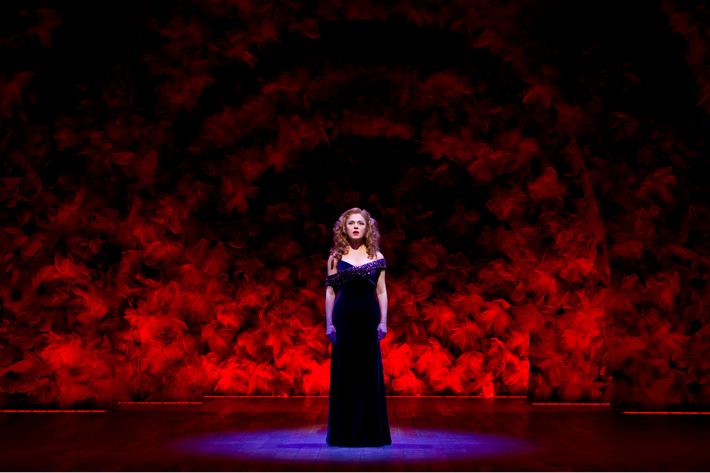

Follies, Stephen Sondheim and James GoldmanÔÇÖs 1971 anatomy of nostalgia, has itself become a talisman of nostalgia. More energy seems to go into venerating it than producing it (this is only its second Broadway revival), probably because itÔÇÖs a tall order: a show that genuflects to the Golden Age even as it seeks to exorcise it. Follies is set the year it opened, 1971, at the first and last gala reunion of the Weismann Follies, a Ziegfeld-like operation that is said to have reigned in the first half of the twentieth century. The theaterÔÇÖs about to be demolished, and looks like itÔÇÖs well on its way to oblivion already ÔÇö timeÔÇÖs already done most of the advance work for the bulldozers. (Derek McLane has draped the loges in what appear to be bolts of denim, but his work onstage is stronger, more convincingly sepulchral, even as the cryptlike mood is in a losing war with the MarquisÔÇÖs sunny, self-satisfied ugliness.) In attendance are two 50ish showgirls, Sally (Bernadette Peters) and Phyllis (Jan Maxwell), and their husbands, Buddy (Danny Burstein) and Ben (Ron Raines). All are unhappily married: Sally, having settled for Buddy back in the day, still pines for her true love, Ben, an up-from-nothing power broker and ex-politician with a soul so battened down, he canÔÇÖt really reach it anymore. (Raines, a lifelong soap-opera actor, has a wry inaccessibility that will likely divide audiences ÔÇö personally, I liked his unsympathetic, almost stunned-looking Ben, all the old charisma turned to taxidermy by years of hollow striving.) Phyllis, meanwhile, laments a life wasted trying to be the polished hood ornament Ben always wanted on the prow of his limousine. Maxwell plays her with attenuated rue, letting the full force of her bitterness build gradually to its crescendo: the stinging Coward-esque waltz ÔÇ£Could I Leave You?ÔÇØ
All regrets in Follies ÔÇö SondheimÔÇÖs formal good-bye to the forms and composers whoÔÇÖd made him who he was ÔÇö come wrapped in pastiche. PetersÔÇÖs ÔÇ£Losing My MindÔÇØ ÔÇö performed with that tremulous, bird-on-a-wire brokenness she continues to refine and deepen ÔÇö is the torch song to end all torch songs. BursteinÔÇÖs attack on ÔÇ£The Right GirlÔÇØ ÔÇö a hurtling dance number that threatens to derail itself at every turn, then turns tender, then furious again ÔÇö bursts forth in a brilliant series of emotional wind sprints that knock the breath right out of you. ItÔÇÖs quite a ride, and Burstein proves, to anyone who didnÔÇÖt know it already, that heÔÇÖs one of our great stage performers ÔÇö a guy who holds nothing back, yet never wastes a drop of energy on insincerity, who shoulders into every scene soul-first, yet never pushes. HeÔÇÖs a great gift: an honest musical-theater actor, and a Sondheim natural. Also? Whatever pieces of your heart are left after BernadetteÔÇÖs through, Burstein will kindly grind to powder for you.
Follies, which in its first draft was an inside-out murder mystery (with two crisscrossed couples, each plotting their spousesÔÇÖ demise), is essentially plotless and entirely dependent on mood. It opens with a parade of showgirls past that elicits awkward bursts of applause from the crowd, as they register their familiarity with the actresses. (Occasionally, I found myself thinking guiltily of the OscarsÔÇÖ notorious ÔÇ£In MemoriamÔÇØ montage, with its asymmetric spasms of ÔÇ£appreciation.ÔÇØ) Look, thereÔÇÖs Bernadette! Jan! And hereÔÇÖs none other than Elaine Paige, who shows up, more or less, to handle the Elaine Stritch Moment: Her ÔÇ£IÔÇÖm Still HereÔÇØ delivers the goods, though more than half of it consists of Paige being, well, There. ItÔÇÖs all a tad unwieldy, and the first twenty minutes are perhaps a shade more funereal than they need to be, in tone and pace. (Did I mention how much I hate the Marquis, with its uncanny, energy-snuffing force field?)
Of course, Sondheim himself, in Finishing the Hat, has called the show ÔÇ£crippled by its size, ambition and mysteriousness, and thus always worth the effort of experimentation.ÔÇØ Director Eric Schaeffer has opted mostly to steer the ship, not reinstall the keel, and, as far as I can tell (which, to be honest, isnÔÇÖt very far), he and choreographer Warren Carlyle have preserved the spirit of Michael BennettÔÇÖs original hoofery. Speaking of which: IÔÇÖd tell you to look for Terri White, who anchors the past-present dance-off showstopper ÔÇ£WhoÔÇÖs That Woman,ÔÇØ but that would imply you need to look: SheÔÇÖs unmissable and undeniable. As for the great Jayne HoudyshellÔÇÖs ÔÇ£Broadway Baby,ÔÇØ itÔÇÖs a wrecking ball of a number, delivered in belts and body blows, by a performer of such focused life force, such irrepressible comic timing, such bulletproof un-self-consciousness, weÔÇÖre momentarily transported ÔÇö but not, it should be noted, to some Golden Past. HoudyshellÔÇÖs Hattie is perhaps the only character who isnÔÇÖt positively septic with nostalgia. She may not be the heart of the show (it has enough hearts, all of them plagued with murmurs and echoes), but she constitutes its lifeline to the Present. SheÔÇÖs an ideal treatment for the subjunctive mood, which is something weÔÇÖre all a little vulnerable to these shaky days. Follies is the disease and the cure in one package: IÔÇÖd advise you to catch it.

